pep小学英语六年级上册全册集体备课教案表格式
- 格式:doc
- 大小:311.50 KB
- 文档页数:42
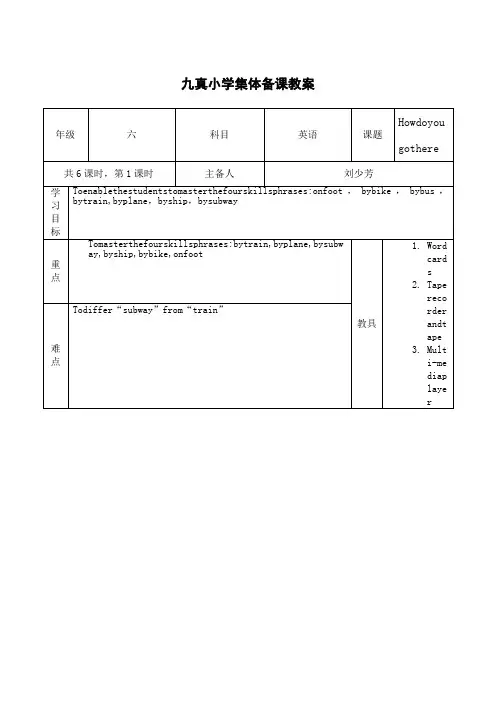
九真小学集体备课教案
九真小学集体备课教案
九真小学集体备课教案
九真小学集体备课教案
九真小学集体备课教案
九真小学集体备课教案
九真小学集体备课教案
九真小学集体备课教案
九真小学集体备课教案
九真小学集体备课教案
九真小学集体备课教案
九真小学集体备课教案
九真小学集体备课教案
九真小学集体备课教案
九真小学集体备课教案
九真小学集体备课教案
九真小学集体备课教案
九真小学集体备课教案
九真小学集体备课教案
九真小学集体备课教案
九真小学集体备课教案。
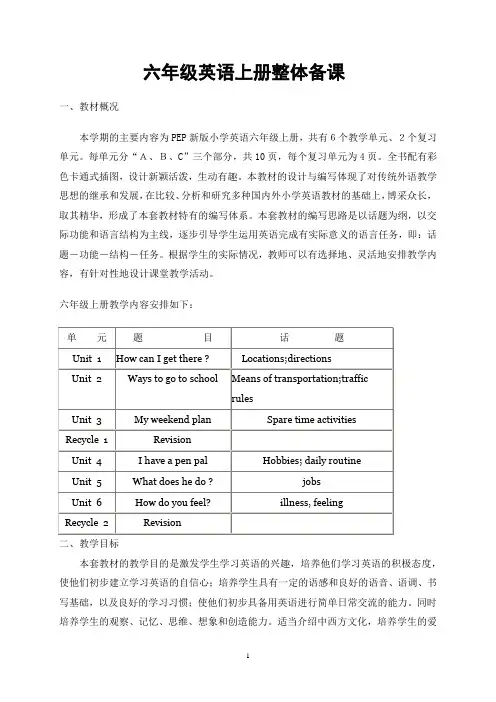
六年级英语上册整体备课一、教材概况本学期的主要内容为PEP新版小学英语六年级上册,共有6个教学单元、2个复习单元。
每单元分“A、B、C”三个部分,共10页,每个复习单元为4页。
全书配有彩色卡通式插图,设计新颖活泼,生动有趣。
本教材的设计与编写体现了对传统外语教学思想的继承和发展,在比较、分析和研究多种国内外小学英语教材的基础上,博采众长,取其精华,形成了本套教材特有的编写体系。
本套教材的编写思路是以话题为纲,以交际功能和语言结构为主线,逐步引导学生运用英语完成有实际意义的语言任务,即:话题-功能-结构-任务。
根据学生的实际情况,教师可以有选择地、灵活地安排教学内容,有针对性地设计课堂教学活动。
六年级上册教学内容安排如下:单元题目话题Unit 1 How can I get there ? Locations;directionsUnit 2 Ways to go to school Means of transportation;trafficrulesUnit 3 My weekend plan Spare time activitiesRecycle 1 RevisionUnit 4 I have a pen pal Hobbies; daily routineUnit 5 What does he do ? jobsUnit 6 How do you feel? illness, feelingRecycle 2 Revision二、教学目标本套教材的教学目的是激发学生学习英语的兴趣,培养他们学习英语的积极态度,使他们初步建立学习英语的自信心;培养学生具有一定的语感和良好的语音、语调、书写基础,以及良好的学习习惯;使他们初步具备用英语进行简单日常交流的能力。
同时培养学生的观察、记忆、思维、想象和创造能力。
适当介绍中西方文化,培养学生的爱国主义精神,增强世界意识,为学生的进一步学习奠定良好的基础。
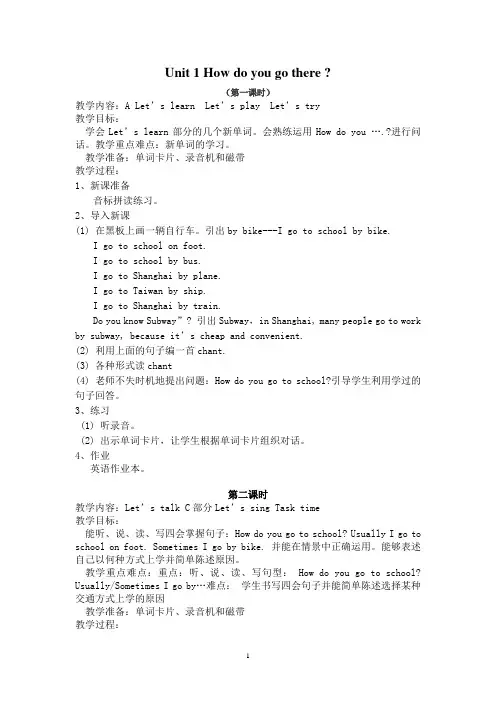
Unit 1 How do you go there ?(第一课时)教学内容:A Let’s learn Let’s play Let’s try教学目标:学会Let’s learn部分的几个新单词。
会熟练运用How do you ….?进行问话。
教学重点难点:新单词的学习。
教学准备:单词卡片、录音机和磁带教学过程:1、新课准备音标拼读练习。
2、导入新课(1) 在黑板上画一辆自行车。
引出by bike---I go to school by bike.I go to school on foot.I go to school by bus.I go to Shanghai by plane.I go to Taiwan by ship.I go to Shanghai by train.Do you know Subway”?引出Subway,in Shanghai, many people go to work by subway, because it’s cheap and convenient.(2) 利用上面的句子编一首chant.(3) 各种形式读chant(4) 老师不失时机地提出问题:How do you go to school?引导学生利用学过的句子回答。
3、练习(1) 听录音。
(2) 出示单词卡片,让学生根据单词卡片组织对话。
4、作业英语作业本。
第二课时教学内容:Let’s talk C部分Let’s sing Task time教学目标:能听、说、读、写四会掌握句子:How do you go to school? Usually I go to school on foot. Sometimes I go by bike. 并能在情景中正确运用。
能够表述自己以何种方式上学并简单陈述原因。
教学重点难点:重点:听、说、读、写句型: How do you go to school? Usually/Sometimes I go by…难点:学生书写四会句子并能简单陈述选择某种交通方式上学的原因教学准备:单词卡片、录音机和磁带教学过程:1、热身(1)复习上一课时对话(2)放Let’s sing 的歌曲2、预习(1)教师出示单词卡片,提问:How do you go to school?(2)做Let’s try的题目。
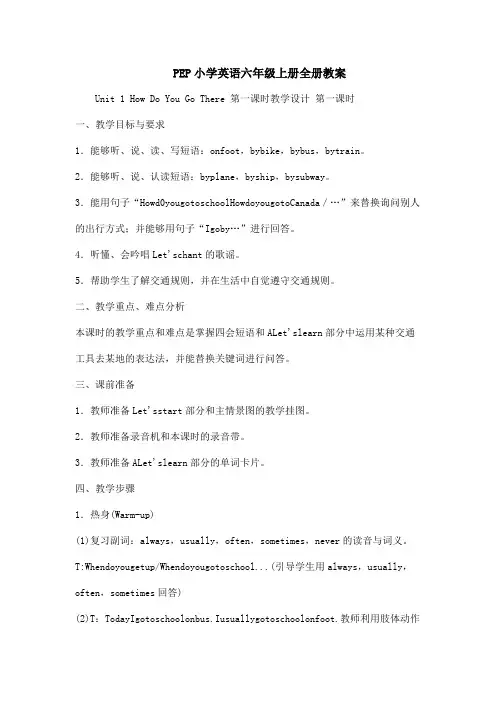
PEP小学英语六年级上册全册教案Unit 1 How Do You Go There 第一课时教学设计第一课时一、教学目标与要求1.能够听、说、读、写短语:onfoot,bybike,bybus,bytrain。
2.能够听、说、认读短语:byplane,byship,bysubway。
3.能用句子“Howd0yougotoschoolHowdoyougotoCanada/…”来替换询问别人的出行方式;并能够用句子“Igoby…”进行回答。
4.听懂、会吟唱Let'schant的歌谣。
5.帮助学生了解交通规则,并在生活中自觉遵守交通规则。
二、教学重点、难点分析本课时的教学重点和难点是掌握四会短语和ALet'slearn部分中运用某种交通工具去某地的表达法,并能替换关键词进行问答。
三、课前准备1.教师准备Let'sstart部分和主情景图的教学挂图。
2.教师准备录音机和本课时的录音带。
3.教师准备ALet'slearn部分的单词卡片。
四、教学步骤1.热身(Warm-up)(1)复习副词:always,usually,often,sometimes,never的读音与词义。
T:Whendoyougetup/Whendoyougotoschool...(引导学生用always,usually,often,sometimes回答)(2)T:TodayIgotoschoolonbus.Iusuallygotoschoolonfoot.教师利用肢体动作帮助学生理解句子意思。
T:WhataboutyouDoyougobybikeorbybusDoyougoonfootOrbycar师生之间自由会话,引出几种常见的交通方式。
引导学生看本课Let’sstart部分的标图并回答问题。
2.预习(Preview)(1)Let'schant教师放本课Let'schant部分的录音,唱到onfoot时,全班跺跺脚;唱到byCar /bike/bus/plane/train的时候,学生做出相应的动作。

六年级上册英语备课Unit 1 How do you go there ?第一课时一、教学内容:PartA Let's learn部分二、教学目标:1.能够听、说、读、写短语:on foot,by bike,by bus,by train。
2.能够听、说、认读短语:by plane,by ship,by subway。
3.能用句子“How do you go to school?How do you go to Canada/…?”来替换有关询问别人的出行方式;并能够用句子“I go by…”进行回答。
4.能够听懂、会吟唱Let's chant的歌谣。
三、教学重难点:本课时的教学重点和难点是掌握四会短语和A Let's learn部分中运用某种交通工具去某地的表达法,并能替换关键词进行问答。
四、教学准备:1.教师准备录音机和本课时的录音带。
2.书上几种交通工具的图片及以前学过的几种交通工具的图片:car,boat,jeep,motorbike,还有脚的图片.五、预习提纲附县下发的预习提纲。
六、教学过程:(一)Warm---up (热身及预习展示)师生自由问答:T:Hello,nice to meet you!Ss:Nice to meet you!T:What's the weather like today?Ss:It's sunny!T:Can you spell "sunny"?Ss:Yes,S-U-N-N-Y,sunny.T:Good!What's this in English?Ss:A book.T:Yes,It's my book.T:Show me your fingers,please.Touch your nose,touch your face,touch your head...touch your foot.T:Good!Can you spell "foot"?Ss:Yes,F-O-O-T,foot.T:Good.This is a big foot.(出示脚的图片)Now,say after me.T:This is my foot.I have a big foot.Do you have a big foot?I can draw a foot....T:Look,one foot,two......Ss:Two feet.T:Good,two feet.I have two feet.How many feet do you have?How many feetcan you see?These are my feet.My feet are big.T:Look!I can draw a picture.(二)Presentation and practice(精讲点拨)(1)教师在黑板上画一座房子,说:This is my home..再画一所四层的大楼,为我们小学,(它们之间很近)教师画一条路,再画一个闹钟,说:"look,what time is it?”学生看后说;“It…s nine o‟clock.""Good,it's time to go to school!My home is near,I go to school on foot."教师边说边做背书包上学的动作,同时脚踏地慢慢往前走,让学生感受句型,教师多说几遍,把句型书写在黑板上,划出词组,让学生跟读,自己体会,让学生根据自己的实际情况来说自己是走路上学,体会on的意思.(2)教师再画一座房子,离学校很远,说:"Now,this is my home ,my home is here.It' s far from my school.I go to school by bike.(教师边说边做骑车的动作)"把此句型写在黑板上,教读,学生体会,并介绍自己是骑车来上学.(3)教师出示自行车的卡片,同时拿出别的交通工具的卡片,放在句型中bike 的上面,进行替换,学生说完整的句子,I go to school by ship.I go to school by bus.I go to school by plane.(4)出示train的图片,问:"What's this in English?Oh,it's a train.train.教师带领学生组词造句,巩固此单词.S1:This is a train.S2:I have a train.S3:There is a train.S4:I can see a train.S5:The train is on the desk.S6:How many trains can you see?S7:How many trains do you have?S8:I go to school by train.S9:I like train.S10:Where is my train.(5)以同样的方法教单词subway.(6)教师再带读一遍,把一本书卷成一个话筒,做采访人的样子,问一个程度较好的学生,教师可以帮助学生回答,T:Excuse me,How do you go to school?T and S:I go to school on foot.教师多问几位同学,让学生感受问句.教师书写问句,带领学生读,师生交换读,(多种方式读)(7)学生进行操练,先同桌互练,再在全班表演.(8)教师出示几个国家的国旗(图片)问学生:T:Look,is this Japan?Ss:No,it's Canada.T:Good,how do you go to Canada?Ss:(教师拿飞机的卡片)I go to Canada by plane.(9)学生反复造句,自由问答.(三)Consolidation and extension(拓展延伸)(1)让学生采访老师S:How do you go to school?T:I go to school on foot.S:How do you go to Canada?T:I go by plane.教师书写此句在黑板上,讲解省略的部分.学生补充完整省略的部分.(2)学生练习.(3)听磁带,跟读,感受语音语调.(四)Sum-up(总结)(五)The limited—time exercise (限时作业)学生做县下发的限时作业.(六)Check and explain(检查限时作业并反馈)学生互相批阅限时作业,发现问题,分析原因,并且反馈矫正。
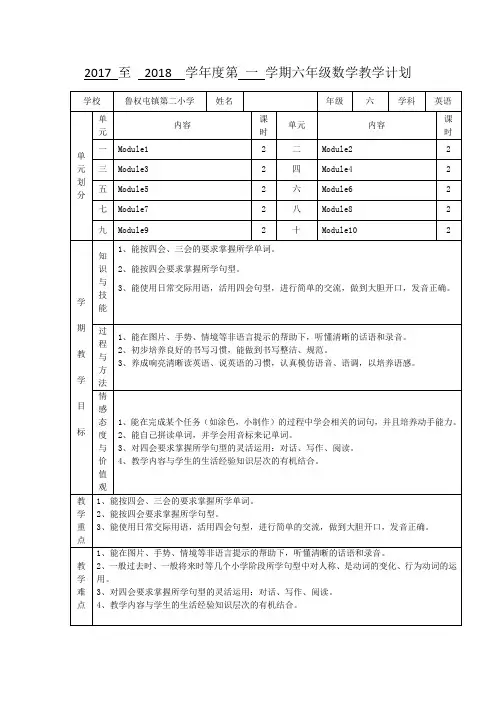
2017 至2018 学年度第一学期六年级数学教学计划Module 1 教学计划一.教材分析Module1通过西蒙和大明的对话引出了重点句型。
Unit 1主要是让学生学会怎样谈论一个地方,例如一个景点、一个城市等等。
学习用数字表达长度、人口数量等。
Unit 2是在前一课的基础上继续谈论某处,特别让学生学会看地图,从地图上找到某一个地方,指出并说出来。
二.教学目标知识与技能:全体学生能朗读课文,阅读相关短文,并能按要求完成语句书写。
过程与方法:对所学内容主动复习和归纳。
情感态度与价值观:乐于接触外国文化,增强祖国意识。
三.教学重难点(1)能听得懂、会说、会读、会拼写单词postcard, more, thousand, million.(2)能听得懂、会说、会读日常交际用语:Tell me more about…. How big is it? / Tell me something about…”等问句,并能回答。
四.课时安排:2课时鲁权屯镇集体备课教案(六年级上册英语学科)鲁权屯镇集体备课教案(六年级上册英语学科)Module 2教学计划一.教材分析本模块利用唐人街的主题引出了there be句型,第二模块继续介绍中国的旅游景点,用“There be”句型描述事物。
二.教学目标知识与技能:全体学生能朗读课文,阅读相关短文,并能按要求完成语句书写。
过程与方法:运用已学语言描述一个地方的特征。
情感态度与价值观:了解英语国家的唐人街和中国的自然、人文景观。
乐于接触外国文化,增强祖国意识。
三.教学重难点用 "There be “句型描述事物。
“there is”和“there are”的用法。
四.课时安排:2课时鲁权屯镇集体备课教案(六年级上册英语学科)鲁权屯镇集体备课教案(六年级上册英语学科)Module 3教学计划一.教材分析利用西蒙的业余爱好是收集邮票这一主题引出了my hobby,全体学生能朗读课文,阅读相关短文,并能按要求完成语句书写。
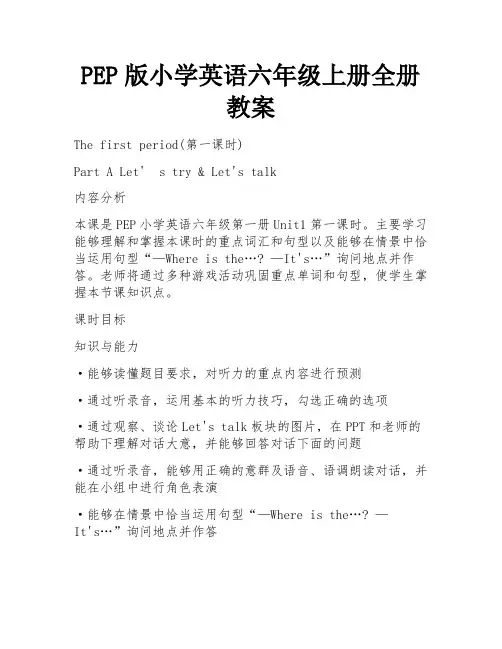
PEP版小学英语六年级上册全册教案The first period(第一课时)Part A Let' s try & Let's talk内容分析本课是PEP小学英语六年级第一册Unit1第一课时。
主要学习能够理解和掌握本课时的重点词汇和句型以及能够在情景中恰当运用句型“—Where is the…? —It's…”询问地点并作答。
老师将通过多种游戏活动巩固重点单词和句型,使学生掌握本节课知识点。
课时目标知识与能力·能够读懂题目要求,对听力的重点内容进行预测·通过听录音,运用基本的听力技巧,勾选正确的选项·通过观察、谈论Let's talk板块的图片,在PPT和老师的帮助下理解对话大意,并能够回答对话下面的问题·通过听录音,能够用正确的意群及语音、语调朗读对话,并能在小组中进行角色表演·能够在情景中恰当运用句型“—Where is the…? —It's…”询问地点并作答·能够在语境中借助图片等帮助理解新词“museum, bookstore, post office, ask, sir”的意思,并能够正确发音·能够运用礼貌用语寻求他人的帮助过程与方法利用机器人创设情境,通过各种不同功能的机器人,激发学生学习兴趣,吸引其注意力。
先引导学生基于语言情境猜测吴一凡所在的场所,再通过听力验证预测的答案并完成Let's try 板块的听力练习,培养学生听前预测的习惯。
情感态度价值观引导学生在小组中相互交流居住地的相关城市设施和位置,拓展学生对自己兴趣爱好和经常活动的表达,提高学生的语言综合运用能力。
教学重难点教学重点能够理解和掌握本节课的重点单词和句型。
教学难点能够在情景中恰当运用句型“—Where is the…? —It's…”询问地点并作答。
教学准备PPT课件、课文录音、视频等。
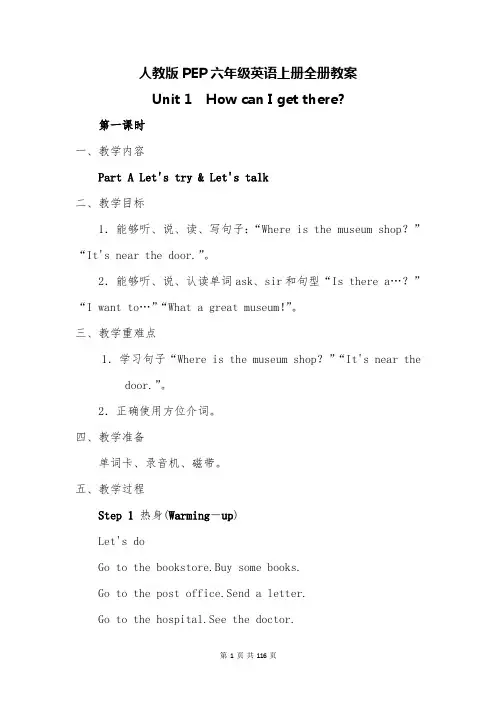
人教版PEP六年级英语上册全册教案Unit 1 How can I get there?第一课时一、教学内容Part A Let's try & Let's talk二、教学目标1.能够听、说、读、写句子:“Where is the museum shop?”“It's near the door.”。
2.能够听、说、认读单词ask、sir和句型“Is there a…?”“I want to…”“What a great museum!”。
三、教学重难点1.学习句子“Where is the museum shop?”“It's near the door.”。
2.正确使用方位介词。
四、教学准备单词卡、录音机、磁带。
五、教学过程Step 1 热身(Warming-up)Let's doGo to the bookstore.Buy some books.Go to the post office.Send a letter.Go to the hospital.See the doctor.Go to the cinema.See a film.Go to the museum.See some robots.Step 2 新课呈现(Presentation)1.学习Let's try(1)打开课本读一读Let's try中呈现的问题和选项。
(2)播放录音,让学生听完后勾出正确的选项。
(3)全班核对答案。
2.学习Let's talk(1)播放Let's talk的录音,学生带着问题听录音:Where is the museum shop?Where is the post office?听完录音后让学生回答这两个问题,教师板书:It's near the door.It's next to the museum.教师讲解:near表示“在附近”,next to表示“与……相邻”,它的范围比near小。
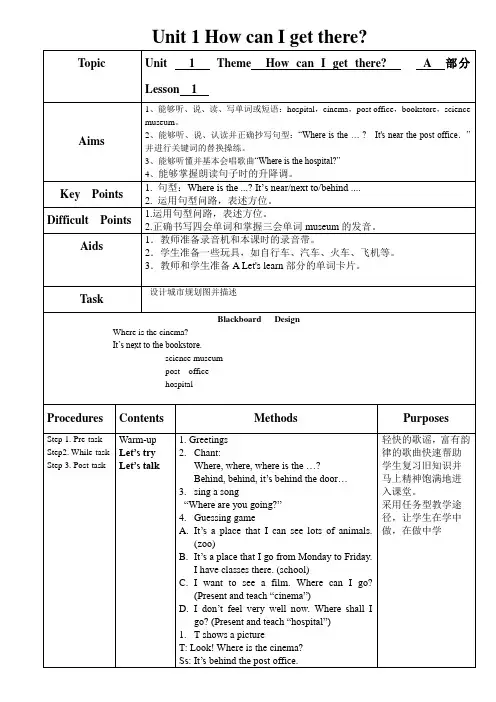
Unit 1 How can I get there?Unit 1 How can I get there?Unit 1 How can I get there?Unit 1 How can I get there?Unit 4 I have a pen palUnit 4 I have a pen palENGLISH TEACHING PLAN (4B)Let's learn 教学目标1、知识与技能2、1能够听、说、读、写本课主要单词factoryworker postman businessman police officer3、2能够听、说、认读单词police officer以及句型what does he do?? He is?并能在情景中运用4、3能够正确使用上述单词和词组谈论和描述任务的职业和生活情况5、过程与方法情景教学法小组合作法图片展示法6、情感态度与价值观有兴趣用英语表达能积极参与活动。
1、正确认读出本课出现的单词factory worker postman businessman police officer并知其意2、掌握本课出现的句型并结合这些句子表达的情境学会恰当的替换句中的单词。
What does he do?he is s businessman.能够正确书写出本课要求四会的单词factory worker postman businessman police officer1教师准备教学过程中所需要的图片、声音、课件以及本课时的六张单词卡。
2、教师准备录音机及录音带。
Blackboard DesignUnit 5 What does he dofactory worker postmanbusinessman police officer[每个单词相应的图片]Main scene教师播放Main scene录音1. 学生听录音三遍。
听第三遍时教师可以鼓励学生小声跟读重复。
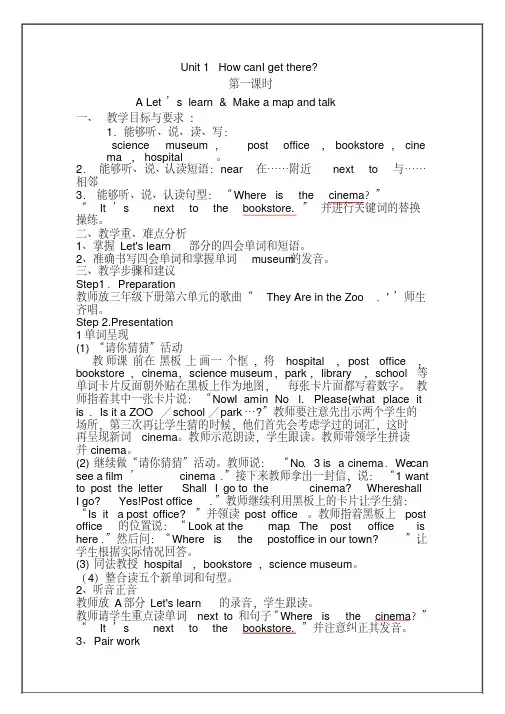
Unit 1 How canI get there?第一课时A Let’s learn & Make a map and talk一、教学目标与要求:1.能够听、说、读、写:science museum ,post office,bookstore,cinema ,hospital 。
2.能够听、说、认读短语:near 在……附近next to 与……相邻3.能够听、说、认读句型:“Where is the cinema?”“It’s next to the bookstore.”并进行关键词的替换操练。
二、教学重、难点分析1、掌握Let's learn部分的四会单词和短语。
2、准确书写四会单词和掌握单词museum的发音。
三、教学步骤和建议Step1.Preparation教师放三年级下册第六单元的歌曲“They Are in the Zoo.'’师生齐唱。
Step 2.Presentation1单词呈现(1)“请你猜猜”活动教师课前在黑板上画一个框,将hospital,post office,bookstore,cinema,science museum,park,library,school等单词卡片反面朝外贴在黑板上作为地图,每张卡片面都写着数字。
教师指着其中一张卡片说:“Now I am i n No·l. Please{what place it is.Is it a ZOO/school/park…?”教师要注意先出示两个学生的场所,第三次再让学生猜的时候,他们首先会考虑学过的词汇,这时再呈现新词cinema。
教师示范朗读,学生跟读。
教师带领学生拼读并cinema。
(2)继续做“请你猜猜”活动。
教师说:“No.3 is a cinema.We can see a film’ cinema.”接下来教师拿出一封信,说:“1 want to post the letter·Shall I go to the cinema? Where s hall I go? Yes!Post office.”教师继续利用黑板上的卡片让学生猜:“Is it a post office?”并领读post office。
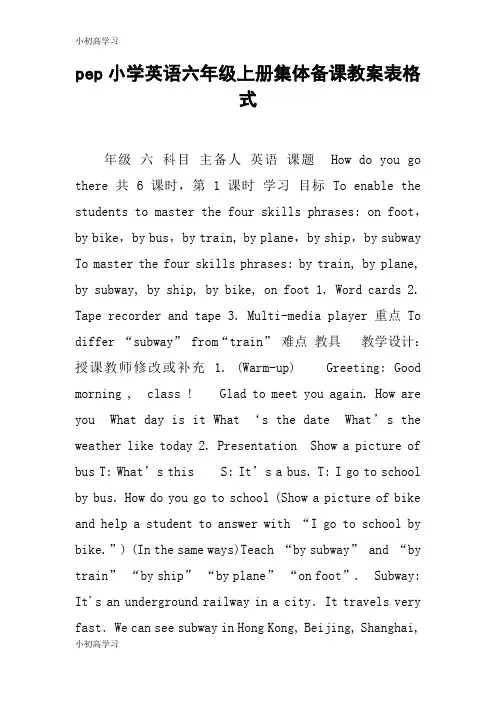
pep小学英语六年级上册集体备课教案表格式年级六科目主备人英语课题 How do you go there 共 6 课时,第 1 课时学习目标 To enable the students to master the four skills phrases: on foot,by bike,by bus,by train, by plane,by ship,by subway To master the four skills phrases: by train, by plane, by subway, by ship, by bike, on foot 1. Word cards 2. Tape recorder and tape 3. Multi-media player 重点 To differ “subway” from“train”难点教具教学设计:授课教师修改或补充 1. (Warm-up) Greeting: Good morning , class ! Glad to meet you again. How are you What day is it What ‘s the date What’s the weather like today 2. Presentation Show a picture of bus T: What’s this S: It’s a bus. T: I go to school by bus. How do you go to school (Show a picture of bike and help a student to answer with “I go to school by bike.”) (In the same ways)Teach “by subway” and “by train”“by ship”“by plane”“on foot”. Subway: It's an underground railway in a city.It travels very fast.We can see subway in Hong Kong, Beijing, Shanghai,Gongzhou… Explain the differences between subway and train Pay attention to the pre. “ by”& “on” 3. Play games教学设计:授课教师修改或补充 Ask one S to the front and stick the word cards next to the phrases written on the Bb when T read the new phrases quickly and the other Ss put up their cards. The one who reflect fastest and correctly is the winner. 4. Listen to the tape of Part A Let’s learn and follow it. Pay attention to the tone and pronunciation 5. Practice: Let’s play T Offer many places (the USA. England Australia Hong Kong Shanghai Guangzhou the moon…) and traffic ways (by car/ taxi/ bus… on foot) Ss practice with above places and ways in pairs: A: How do you go to school B: I go to school on foot . Encourage the Ss to make up as many sentences as they can. 6. Spelling xxpetition Divide the class into tow groups. Show the pictures of traffic tools and ask Ss to spell the phrases. The first one who puts up hand gets the chance to spell. The group spell out more phrases are the winners. Homework Copy the new words and phrases Finish Page1 of the AB Bb design: Unit One How doyou go there How do you go to school/ Canada I go to school on foot/ by subway/ bus/ train/ taxi…教学反思:年级六科目主备人英语课题 How do you go there 共 6 课时,第 2 课时学习目标重点难点sentence: “How do you go to school Usually I go to school on foot.Sometimes I go by bike.” sentences: How do you go to schoolUsually I go to school by bike. Sometimes I go on foot Tape recorder Teaching cards a piece 教具 of paper sentences: How do you go to school Usually I go to school on I go by bike. 教学设计: 1. (Warm-up) T: Good morning! How do you go to school today What about you Do you go by bus,too” 2. Havea dictation Ask the Ss to dictate the new words learntin the last lesson. On foot、 by bus、 by train、 by plane、 by subway… 3. Let'stry Guide the Ss to look at the pictures and ask Who’s the boy He’s Mike. How does Mike go to school 4. (Presentation) Let's talk T: How do I go to school,do you know Ask me,please! Draw a bike, a bus, a taxi on the Bb and write the price by each picture. Bus 1 yuan taxi 10 yuan Encourage the Ss to ask “How do you go to school T: Usually Igo to school by bike, because it's good exercise.Sometimes I go by bus,because it's cheap.It costs l yuan. Sometimes I go by taxi,because it's fast,but it's too expensive.It costs 1o yuan.授课教师修改或补充教学设计:授课教师修改或补充 Explain that we use usually and sometimes to express frequency T: “How does Sarah go to school Listen.” Ask the S to imitate Sarah’s tone to answer Sarah: Usually I to go school on foot. Sometimes I go bike. Ss read after the tape. Then practice in pairs to make up the new dialogue according to each picture. Ask several pairs to act out the dialogue. 5. Group work Read the dialogue .Then practice in groups of four. They can expand their dialogue like the following: A:How do you go to school/ hometown B:Usually I go by bus.A:Can you go by bike B: Yes,I can,but it's too far.Sometimes I go by taxi,because it’s fast, but it's expensive. What about you A:I go to school on foot,because my home is near. 6. Play finding order games Show the following word cards and ask Ss to form correct sentences. How, do, go, to, school, you I,usually, on, go, school, to, foot Sometimes, by, bike, go, I Homework: Finish AB Page2 Bb design Unit1 How do you go there How do you go to school Usually I go to school on foot, because it’s near. Sometimes I go by bike, because it’s fast. 教学反思:年级六科目主备人英语课题 How do you go there 共 6 课时,第 3 课时学习目标 3. 1. To improve reading skill 2. To consolidate the traffic ways To improve understanding ability. 重点 How do we go to the park? It’s easy. How to finish answering the questions in the book How to express the different ways to a 难点 place 教具 Tape recorder a piece of paper masks of Zhang Peng and Sarah 教学设计: 1. Review Free talk 2. Dictation 复习上节课学过的句子和词语 How do you go to school Usually I go to school on foot. Sometimes I go by bike. What about you 3. Review different places 4. Presentation T: Where is my home Do you want to know Describe with different traffic ways and use “first”“next”“then” . It’s a little far from here. First I go to Zenbu bus stop on foot. Then I can go by the bus to the East Bus Station... We live on the ninth floor,Room902. Explain “then”授课教师修改或补充年级六科目主备人英语课题 How do you go there 共 6 课时,第 1 课时学习目标 To enable the students to master the four skills phrases: on foot,by bike,by bus,by train, by plane,by ship,by subway To master the four skills phrases: by train, by plane, by subway, by ship, by bike, on foot 1. Word cards 2. Tape recorder and tape 3. Multi-media player 重点 To differ “subway” from“train”难点教具教学设计:授课教师修改或补充 1. (Warm-up) Greeting: Good morning , class ! Glad to meet you again. How are you What day is it What ‘s the date What’s the weather like today 2. Presentation Show a picture of bus T: What’s this S: It’s a bus. T: I go to school by bus. How do you go to school (Show a picture of bike and help a student to answer with “I go to school by bike.”) (In the same ways)Teach “by subway” and “by train”“by ship”“by plane”“on foot”. Subway: It's an underground railway in a city.It travels very fast.We can see subway in Hong Kong, Beijing, Shanghai, Gongzhou… Explain the differences between subway and train Pay attention to the pre. “ by”& “on” 3. Playgames教学设计:授课教师修改或补充 Ask one S to the front and stick the word cards next to the phrases written on the Bb when T read the new phrases quickly and the other Ss put up their cards. The one who reflect fastest and correctly is the winner. 4. Listen to the tape of Part A Let’s learn and follow it. Pay attention to the tone and pronunciation 5. Practice: Let’s play T Offer many places (the USA. England Australia Hong Kong Shanghai Guangzhou the moon…) and traffic ways (by car/ taxi/ bus… on foot) Ss practice with above places and ways in pairs: A: How do you go to school B: I go to school on foot . Encourage the Ss to make up as many sentences as they can. 6. Spelling xxpetition Divide the class into tow groups. Show the pictures of traffic tools and ask Ss to spell the phrases. The first one who puts up hand gets the chance to spell. The group spell out more phrases are the winners. Homework Copy the new words and phrases Finish Page1 of the AB Bb design: Unit One How do you go there How do you go to school/ Canada I go to school on foot/ by subway/ bus/ train/ taxi…教学反思:年级六科目主备人英语课题 How do you go there 共 6 课时,第 2 课时学习目标重点难点sentence: “How do you go to school Usually I go to school on foot.Sometimes I go by bike.” sentences: How do you go to schoolUsually I go to school by bike. Sometimes I go on foot Tape recorder Teaching cards a piece 教具 of paper sentences: How do you go to school Usually I go to school on I go by bike. 教学设计: 1. (Warm-up) T: Good morning! How do you go to school today What about you Do you go by bus,too” 2. Havea dictation Ask the Ss to dictate the new words learntin the last lesson. On foot、 by bus、 by train、 by plane、 by subway… 3. Let'stry Guide the Ss to look at the pictures and ask Who’s the boy He’s Mike. How does Mike go to school 4. (Presentation) Let's talk T: How do I go to school,do you know Ask me,please! Draw a bike, a bus, a taxi on the Bb and write the price by each picture. Bus 1 yuan taxi 10 yuan Encourage the Ss to ask “How do you go to school T: Usually I go to school by bike, because it's good exercise.Sometimes I go by bus,because it's cheap.Itcosts l yuan. Sometimes I go by taxi,because it's fast,but it's too expensive.It costs 1o yuan.授课教师修改或补充教学设计:授课教师修改或补充 Explain that we use usually and sometimes to express frequency T: “How does Sarah go to school Listen.” Ask the S to imitate Sarah’s tone to answer Sarah: Usually I to go school on foot. Sometimes I go bike. Ss read after the tape. Then practice in pairs to make up the new dialogue according to each picture. Ask several pairs to act out the dialogue. 5. Group work Read the dialogue .Then practice in groups of four. They can expand their dialogue like the following: A:How do you go to school/ hometown B:Usually I go by bus.A:Can you go by bike B: Yes,I can,but it's too far.Sometimes I go by taxi,because it’s fast, but it's expensive. What about you A:I go to school on foot,because my home is near. 6. Play finding order games Show the following word cards and ask Ss to form correct sentences. How, do, go, to, school, you I, usually, on, go, school, to, foot Sometimes, by, bike, go, I Homework: Finish AB Page2 Bb design Unit1 Howdo you go there How do you go to school Usually I go to school on foot, because it’s near. Sometimes I go by bike, because it’s fast. 教学反思:年级六科目主备人英语课题 How do you go there 共 6 课时,第 3 课时学习目标 3. 1. To improve reading skill 2. To consolidate the traffic ways To improve understanding ability. 重点 How do we go to the park? It’s easy. How to finish answering the questions in the book How to express the different ways to a 难点 place 教具 Tape recorder a piece of paper masks of Zhang Peng and Sarah 教学设计: 1. Review Free talk 2. Dictation 复习上节课学过的句子和词语 How do you go to school Usually I go to school on foot. Sometimes I go by bike. What about you 3. Review different places 4. Presentation T: Where is my home Do you want to know Describe with different traffic ways and use “first”“next”“then” . It’s a little far from here. First I go to Zenbu bus stop on foot. Then I can go by the bus to the East Bus Station... We live on the ninth floor,Room902. Explain “then”授课教师修改或补充。
Unit 1 How can I get there?第一课时A Let’s learn,Make a map and talk一、教学目标:1能够听、说、读、写science museum, post office, bookstore, cinema, hospital.2能够听、说、认读短语:near 在……附近, next to 与……相邻3能够听、说、认读句型:Where is the cinema?It’s next to the bookstore. It’s near the park.并进行关键词的替换操练。
二、教学重、难点1、掌握Let's learn部分的四会单词、短语及句子。
2、准确书写四会单词和掌握单词museum的发音。
三、教学过程Step1.Preparation教师放三年级下册第六单元的歌曲“They Are in the Zoo.'’师生齐唱。
Step 2.Presentation1单词呈现(1)“请你猜猜”活动教师课前在黑板上画一个框,将hospital,post office,bookstore,cinema,science museum,park,library,school等单词卡片反面朝外贴在黑板上作为地图,每张卡片面都写着数字。
教师指着其中一张卡片说:“Now I am in No.l. Please{what place it is.Is it a zoo/school/park…?”教师要注意先出示两个学生的场所,第三次再让学生猜的时候,他们首先会考虑学过的词汇,这时再呈现新词cinema。
教师示范朗读,学生跟读。
教师带领学生拼读并cinema。
(2)继续做“请你猜猜”活动。
教师说:“No.3 is a cinema.We can see afilm’cinema.”接下来教师拿出一封信,说:“1 want to post the letter. Shall I go to the cinema? Where shall I go? Yes! Post office.”教师继续利用黑板上的卡片让学生猜:“Is it a post office?”并领读post office。
政治教师年终总结模板不经意间,一学年很快就过去了。
开学时面对这届初三学生的实际情况,考虑到学校的高要求,我感到肩上的担子特别沉重。
现在终于结束了,后面还有个不长不短的暑假,可以喘一口气,停下来写一个工作小结。
因为自己身上的问题很多,所以一直不敢做自我小结。
其实这是非常错误的,我们本该经常批评和自我批评,这样人才能进步。
我先指出我自己的问题是明明内心知道这件事不对,却还是去说去做了,我想这大概就是普通人和能够取得一些成绩的人之间的区别吧。
还有个致命的毛病是不会装糊涂,什么事情总要搞得很清楚,其实有些事情是永12、认真抓好教学常规,认真备好每一堂课,上好每一堂课,认真批改作业。
进行“研究型备课”。
以教材、学生、教法、教具作为研究对象,查阅资料,加强对知识认识的广度和深度,全面、准确的掌握知识,而且做到融会贯通,从整体上把握学科知识体系,创造性的组织教材,形成个人的体验和认识。
引导学生打通书本世界和生活世界之间的界限,将生活和书本知识融合起来。
在课堂教学中,培养学生主动参与的意识,使学生的思维都能活跃起来,都能开动脑筋,积极去思考问题、钻研问题,促进思维能力的发展。
在作业的布置上,不局限于重复性问题。
而是注重课外小试验、小制作、资料的查阅和搜集等。
布置的作业及时的检查,并做出客观、积极的评价,让他们感受到成功的喜悦,增强学习的乐趣。
3、认真搞好集体备课和听评课活动。
通过集体备课,实现优势互补,资源共享,优化课堂教学。
对教材中的重点、难点以及教学方法,精心分析、讨论,探讨突出重点、突破难点、促进学生发展的思路和方法。
同时,通过听评课活动,加深对教材的理解、教法的把握,提高课堂教学水平。
4、加强对尖子生的培养和对后进生的辅导工作。
我们采取了“抓两头,促中间”的教学策略。
对于尖子生的培养,采取“带研究生”的方式。
课堂上,对于一些有难度、有深度的问题多让尖子生回答。
课下,精选一些竞赛题进行训练。
更重要的是,培养他们学习物理的兴趣和善于钻研的学习习惯,提高他们的思维能力。